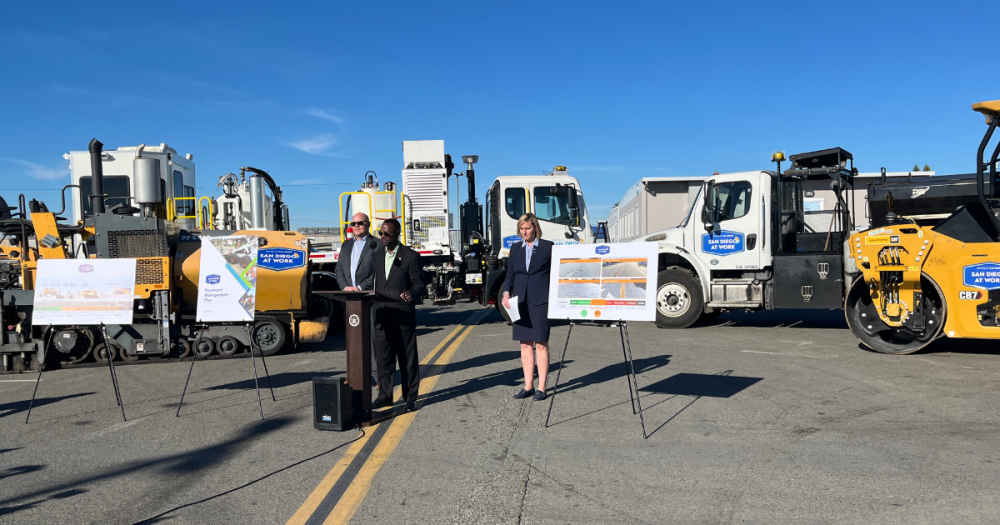San Diego Unveils Results of Street Condition Assessment
January 18, 2024 | City News Team

For the first time in seven years, the City of San Diego has completed a condition assessment of every paved street segment in every neighborhood, collecting data that will help guide decisions on how to prioritize and fund road repair. This evaluation of street conditions, known as a Pavement Condition Index (PCI), is included in a comprehensive Pavement Management Plan, released this week by the City’s Transportation Department to outline a data-driven strategy for pavement management in future years.
“All San Diegans deserve smooth roads in their neighborhoods,” Mayor Gloria said. “The recent results of the Pavement Condition Index and associated Pavement Management Plan will give us the tools to be more strategic and efficient when it comes to improving and resurfacing our street network now and in the future.”
In calculating the data gathered during the street condition assessment, which was completed over the course of several months last spring, the City scored 63 points on the PCI, which puts San Diego’s road network in the “Fair” category. PCI scores range from zero to 100 with a target network average of 70 being the industry standard.
During the data-gathering process, all of San Diego’s paved roadways were analyzed by lasers and other tools to measure pavement surface distress, such as cracks and potholes. The resulting scoring scale includes seven condition categories: Good (85-100), Satisfactory (70-84), Fair (55-69), Poor (40-54), Very Poor (25-39), Serious (10-24) and Failed (<10).
In the FY24 budget, Mayor Todd Gloria dedicated a record $140 million investment to repair City streets by focusing on repairing San Diego’s high-volume roadways. In 2023, 254 miles of roadway were repaired or resurfaced, and more than 61,300 potholes were filled, a 94% increase over the prior year.
With a network of paved roads, alleyways and unimproved streets, the City of San Diego maintains more than 6,600 lane miles of roadway. As pavement deteriorates, the cost of repair increases rapidly. Prior to this year, the City performed its last road condition assessment in 2016, resulting in a PCI score of 71. The City has not had enough funding to perform assessments at the recommended frequency of every four years. Despite limited and fluctuating funding levels, the Transportation Department maximizes its resources to address and prevent as many pavement issues as possible.
“Every day, our City crews are out repairing streets and filling potholes. Having this updated pavement condition assessment will help us be more strategic with how we allocate our resources in the future,” said Eric Dargan, Chief Operating Officer for the City of San Diego. “While we are heading into a lean budget year, we know that our residents expect and deserve to have to safe, smooth streets. Using a data-driven strategy will allow us to be more efficient and prioritize roads for repair in all of our neighborhoods across the city.”
The Pavement Management Plan points out that funding for road repair in the City has been inconsistent over the past 10 years and has been dependent on impacts to the City’s General Fund budget. The Pavement Management Plan examines future funding scenarios needed to bring the City’s street network to an average 70 PCI.
The City maintains the second largest network of roads and alleys in California that serve over 1.37 million residents. In the Pavement Management Plan, comparisons are shown between the City of San Diego and 13 other agencies of similar size in road network and population.
Four main factors were used to benchmark the City against other agencies, including PCI funding sources, maintenance trends and annual mileage of road repairs conducted. Five of the 13 benchmarked cities currently have an average roadway network PCI greater than or equal to the City's PCI target of 70. The City's 2023 network average PCI of 63 ranks below both the average and the median of the 13 cities evaluated in addition to the average PCI for the state of California, which is currently at 65.
“The results of the PCI analysis show us we aren’t where we need to be concerning the conditions of our streets” said Bethany Bezak, Director of the City’s Transportation Department. “Now that we have this data, it allows us to put a long-term plan in place to better strategically and cost-effectively fix our roads.”
In addition to summarizing current City street conditions to identify strategic investment and funding needs, the Pavement Management Plan outlines the Transportation Department’s functions and processes related to pavement management, historical and recent pavement condition assessment information.
Along with the release of the Pavement Management Plan, the City has developed a Five-Year Paving Plan that shows which streets would be paved in the next five fiscal years if the Department were to receive the funding requested in the Pavement Management Plan. The Five-Year Paving Plan has been added to the newly relaunched StreetsSD, an interactive webpage that provides San Diegans with specific information about individual streets.
The relaunched StreetsSD page has been updated with an improved user-friendly interface that allows residents to see ongoing and future paving project plans, when streets were last resurfaced, and current pavement conditions. They can also provide feedback to the City about the streets in their neighborhood.
To view the complete Pavement Management Plan and to learn more about road repair, visit the Pavement Management Plan page on the City’s website.
Filter by Category
Airports (1)
Arts and Culture (9)
Business (20)
City Planning (1)
Environment (46)
Human Interest (7)
Library (14)
Parks and Recreation (21)
Personnel (11)
Public Safety (20)
Public Works (58)
Streets (1)
Technology (4)
Transportation (1)
Airports (1)
Arts and Culture (9)
Business (20)
City Planning (1)
Environment (46)
Human Interest (7)
Library (14)
Parks and Recreation (21)
Personnel (11)
Public Safety (20)
Public Works (58)
Streets (1)
Technology (4)
Transportation (1)
